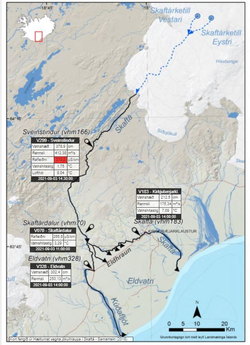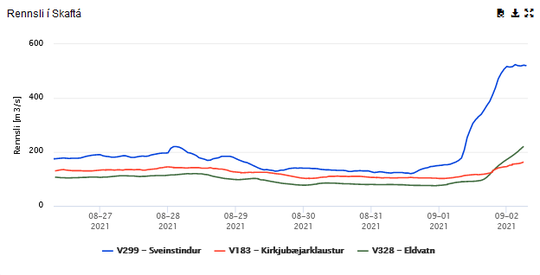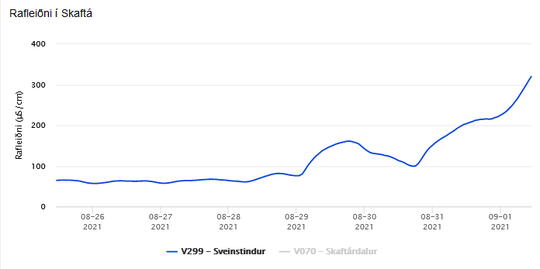
Flood from Skaftá
The flood in Skaftá is still ongoing but the discharge has lowered significantly.
Updated 10.09. 15:25
The flood in Skaftá is still ongoing but the discharge has lowered significantly.
The water level in Tungulækur, which is a groundwater stream from Eldhraun, continues to rise slightly, indicating that floodwater is still spreading through the lava. Gas pollution close to the edge of the Skaftá river remains a possibility.
The IMO has issued a yellow warning for heavy rainfall in southern Iceland, including Eldhraun. The warning takes effect on Sunday afternoon, and streams and rivers in the region could be subject to flooding, particularly for water courses that are swollen already.
Updated 9.9. 11:00
The discharge of Skaftá by Sveinstindur has been lowering and is now under 600 m3/sek. The discharge by Eldvatn has also lowered from yesterday. There is still some time until Skaftá will reach it‘s balance and the flood water is expected to spread around the lowland area for the next few days.
Yesterday, specialists from the Icelandic Met office took a flight over the flood area to analyze the impact of the flood. The extent of the flood, close to the glacier, was smaller than the extent of the flood in 2018, which is in correspondence with lower peak discharge of the current flood. The impact of the flood close to the main road will appear in the coming days since flood water is still seeping through the lava.
Updated 6.9. 15:10
Shortly after midday today, 6 September, the discharge of Skaftá at Sveinstindur began to increase rapidly. At 14:00, the discharge was 610 m3 / s and rising swiftly. The course of events is in line with earlier estimations. There is still some time until the flood will peak at Sveinstindur. A similar flood in 2018 peaked at 2000 m3 / s, but that value does not take into account floodwater that flowed around the gauging location.
Updated 6.9. 13:45
According to the latest measurements, floodwater from the eastern cauldron will reach Sveinstindur this evening, 6 September. Based on previous examples, it is likely that the flood from the eastern cauldron will peak at Sveinstindur about 30 hours after first being detected there. By Wednesday morning, 7 September, the flood front will have reached Eldvatn in the southern lowlands. The discharge of Skaftá will continue to increase in the lowlands, with a flood peak expected on Wednesday evening or early on Thursday, 9 September.
Updated 5.9. 12:45
GPS measurements from Vatnajökull glacier show that the surface of Eastern-Skaftá cauldron has started to subside. That indicates that slowly the glacieal melt water will drain and in consequence a glacial flood is imminent. Last flood from the Eastern-Skaftá cauldron occurred in August 2018 but minor flood from the western cauldron was in September 2019. Measurements show the surface of the cauldron has subsided 1 m since 23:00 last night. Initially the water flows 40 km long path below the glacier and then 20 km along Skaftá before it reaches the first hydrological station at Sveinstindur (See map). Maximum discharge during floods from the Eastern cauldron has previously reached 3.000 m3/s but last flood in 2018 peaked at 2.000 m3/s. If compared to the flood in 2018 the first hyderological station will see the first signs of flood water in the morning of the 6th of September.
IMO will monitor this event closely and send out more information as it is progressing.
Updated 3.9. at 15:25
Discharge has been slowing in Skaftá by Sveinstindar for the past hours and at 14:30 the measuring was 412 m3/s. The discharge was at it‘s peak around midnight on the 2nd of September and was the around 520 m3/s.
When looking at the advancement of the flood and comparing it to former floods from the western crater it is likely that floodwater will be visable for the next few days and discharge measurements will be high for this time of year.
Updated 2.9. at 12.30
Discharge has been stable in Skaftá at Sveinstindur over the last few hours, measuring now at around 520 m3/s. It is likely that the runoff has peaked when looking at the previous flood of western cauldron.
As can be seen on the picture below, the flow is gradually increasing downstream, but typically it takes the floodwater around 8-10 hours to come through from the meter at Sveinstindur and the meter at Eldvatn by Ása.
Hydrogen sulfide travels with the running water from under the glacier.

The flow is gradually increasing downstream, but typically it takes the
floodwater around 8-10 hours to come through from the meter at
Sveinstindur and the meter at Eldvatn by Ása.
From 1.9.
Steadily increased conductivity has been observed in Skaftá at Sveinstindur hydrological station for the last two days followed by increased discharge during the last hours. The IMO has also received reports of sulfuric smell in the nearby ares. It is not considered that snow melt or precipitation is causing these changes and therefore, it is likely that a glacial flood has started. Discharge at Sveinstindur was 290 m3/s at noon but maximum discharge is not expected to exceed 750 m3/s .
Data indicates that the flood originates from the western Skaftá-cauldron. Last flood from there occurred in September 2019 and before that in August 2018. Discharge in floods from the western Skaftá-cauldron are usually smaller than floods from the eastern cauldron.
IMO will monitor this event closely and send out more information as it is progressing.

Discharge at Sveinstindur was 290 m3/s at noon but maximum discharge is not expected to exceed 750 m3/s
Electrical conductivity in Skaftá.
Possible hazards
It is important that locals and people traveling in the area are aware of possible hazard and conditions there.
- In the next few days, it is possible that Skaftá will overflow roads that lie close to the river's pathway.
- High values of H2S are expected near the margin of Skaftárjökul and people are advised to stay at a safe distance from the river and the margins of nearby glaciers.
- Crevasses will form rapidly around the cauldron, therefore people travelling on Vatnajökull ice-cap should stay away from the cauldrons and margins of glaciers where floodwater is emerging.
Background information
The Skaftá cauldrons, eastern and western, are located in the western part of Vatnajökull Ice-cap. They form because of geothermal activity that melts the glacier from below and water accumulates beneath them. When the hydro static pressure is high enough for the water to lift the ice above and flow from below the cauldrons it causes a flood. Floods from the eastern-cauldron are usually larger than the floods from the western-cauldron. Floods from the Skaftá-cauldrons as we know them today were first observed 1955 and since then 58 floods have occurred. On average floods from each cauldron occur every two years.




